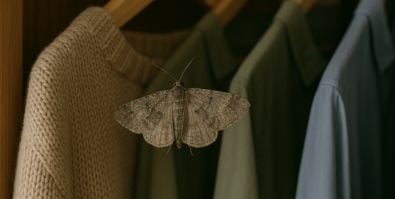Moths in the wardrobe always catch homeowners off guard, especially when expensive clothes start developing holes. These pests can destroy natural fabrics faster than expected. Fortunately, learning how to get rid of moths in wardrobe areas doesn't require special expertise. A solid plan and some persistence will eliminate these unwanted guests and prevent their return.
How to identify wardrobe moths and their damage
Two species cause most wardrobe problems: webbing clothes moths and case making clothes moths. Both measure about half an inch long with cream or golden wings. Adult moths get the blame, but their larvae actually eat the clothes. These tiny caterpillars feed on natural fibers, creating those annoying holes that homeowners discover too late.
Signs of moths in your wardrobe
Holes in clothing provide the clearest evidence of moth activity, particularly in wool, silk, or cashmere pieces. These holes usually develop in folded areas, since larvae avoid bright light and activity.
Additional warning signs:
- Small, pale larvae crawling on clothes or wardrobe walls
- Webbing or tiny cases stuck to fabric surfaces
- Adult moths flying around bedroom areas
- Fine dust accumulating on clothing or shelves
Silk threads on garments show active feeding spots. White specks scattered on fabrics are moth eggs, though they're difficult to spot without close examination.
Why moths love wardrobes and natural fabrics
Wardrobes offer perfect conditions - darkness, quiet spaces, and abundant food sources. Natural fibers contain keratin, which supports larval development. Wool, silk, and cashmere become prime targets because of this protein content. Items with food residue or body oils attract even more attention, since these substances boost nutritional value.
How to get rid of moths in wardrobe? – step by step
Eliminating getting rid of moths in closet environments means targeting every development stage. Missing eggs or larvae during treatment often results in repeat infestations within weeks. Effective removal combines thorough cleaning with treatments that break breeding cycles.
Quality wardrobes with good airflow help reduce problems, though regular maintenance stays crucial regardless. Quick action after spotting signs prevents minor issues from becoming major headaches.
Emptying and cleaning your wardrobe thoroughly
Complete emptying comes first - remove every item including clothes, shoes, accessories, and storage containers. This eliminates hiding spots for all life stages during cleaning. Vacuum all surfaces carefully, focusing on corners, cracks, and gaps where eggs hide. Use the narrow attachment behind rods and along baseboards. Wipe surfaces with mild detergent solution afterward, then ensure complete drying.
Using natural remedies – cedar, lavender and essential oils
Natural approaches work well without introducing harsh chemicals. Cedar oils naturally repel moths while making egg laying difficult. Cedar blocks, sachets, and hangers provide ongoing protection when maintained properly. Lavender combines pleasant scent with effective deterrence.
Proven natural methods include:
- Lavender sachets placed throughout storage areas
- Essential oil-soaked cotton balls in corners
- Cedar blocks positioned strategically
- Dried herb bundles in breathable wrapping
When to use moth traps and sprays
Commercial products become necessary when natural methods fall short. Pheromone traps capture male moths, disrupting reproduction while indicating infestation severity. Targeted sprays eliminate larvae and eggs that cleaning might miss, though careful application following instructions is essential. Persistent problems may need professional pest control services.
Preventing moths from coming back
Long-term success with getting rid of moths in house situations requires developing strong prevention habits that become second nature. Stopping new infestations costs far less than repeated treatments, while protecting valuable clothing investments. Understanding what draws moths to wardrobes makes creating unwelcoming storage conditions much easier to achieve.
Proper clothing storage tips
Clean everything thoroughly before storage, since even small stains attract months later. Wash or dry clean all items, ensuring complete drying before putting them away. Store valuable natural fiber pieces in airtight containers, vacuum bags, or cedar-lined chests for maximum protection.
Effective storage habits include:
- Using breathable garment bags instead of plastic
- Maintaining space between items for air circulation
- Rotating seasonal clothing regularly
- Inspecting stored items periodically
Seasonal checks and regular cleaning
Regular maintenance stops small problems from growing into expensive disasters. Deep cleaning twice yearly during seasonal changes allows thorough inspection and deterrent refreshing. Monthly quick checks catch developing issues early without requiring major time investment. Look for new damage, fresh moth signs, and verify deterrents remain fresh and properly positioned throughout storage areas.
Smart storage accessories that keep moths away
Modern storage options often include built-in moth protection requiring minimal ongoing maintenance. Cedar-lined drawers, aromatic containers, and specially treated bags provide continuous protection that works alongside other prevention methods. These accessories create hostile environments for moths while keeping clothes accessible for regular use.
Vacuum-sealed bags eliminate the air access moths desperately need for survival while maximizing available closet space. For particularly valuable clothing collections, climate-controlled storage systems maintain consistent conditions that make moth survival extremely difficult throughout the year.
Keep moths away for good
Successful moth control combines immediate elimination with ongoing protection strategies. Moths in clothes problems stay manageable when thorough treatment meets consistent prevention habits. Regular storage maintenance creates lasting solutions rather than temporary fixes.
Author: Dako Furniture Team


